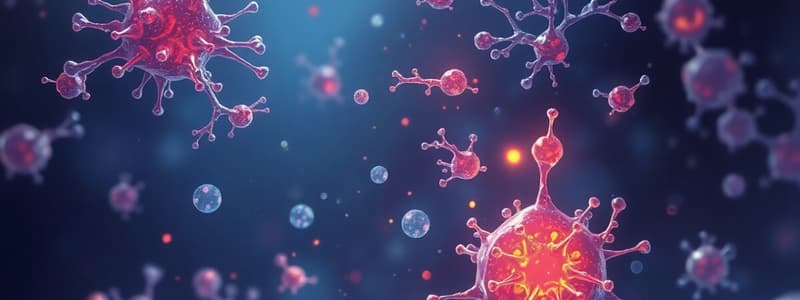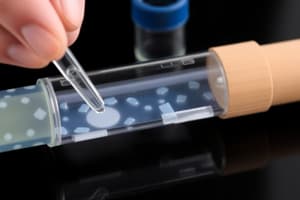Podcast
Questions and Answers
What does a purple colored reaction after adding Kovacs reagent indicate?
What does a purple colored reaction after adding Kovacs reagent indicate?
- Presence of oxidase enzyme (correct)
- Presence of glucose
- Presence of bile salts
- Presence of bacteria
Which characteristic helps differentiate Staphylococcus from Streptococcus?
Which characteristic helps differentiate Staphylococcus from Streptococcus?
- Shape of organisms
- Colony color
- Catalase test results (correct)
- Presence of spores
What does the presence of bubble formation in the catalase test indicate?
What does the presence of bubble formation in the catalase test indicate?
- Negative reaction for Micrococci
- Positive reaction for Staphylococci (correct)
- Positive reaction for Streptococcus
- Negative reaction for Coagulase
Which method detects clumping factor in the coagulase test?
Which method detects clumping factor in the coagulase test?
What does the term 'Gram + cocci' indicate about the organism's morphology?
What does the term 'Gram + cocci' indicate about the organism's morphology?
How can one differentiate Staphylococcus aureus from Coagulase Negative Staphylococci (CoNS)?
How can one differentiate Staphylococcus aureus from Coagulase Negative Staphylococci (CoNS)?
Which characteristic of an organism on a Blood Agar Plate suggests it needs oxygen for growth?
Which characteristic of an organism on a Blood Agar Plate suggests it needs oxygen for growth?
What color change indicates a positive anaerobic acid production test for Staphylococci?
What color change indicates a positive anaerobic acid production test for Staphylococci?
Which feature distinguishes Streptococci during a catalase test?
Which feature distinguishes Streptococci during a catalase test?
Which of the following Staphylococcus species is primarily associated with nosocomial infections related to implanted medical devices?
Which of the following Staphylococcus species is primarily associated with nosocomial infections related to implanted medical devices?
What is the purpose of the bacitracin test when differentiating between Staphylococcus and Micrococcus?
What is the purpose of the bacitracin test when differentiating between Staphylococcus and Micrococcus?
How does the result of the lysostaphin test correlate with bacitracin results?
How does the result of the lysostaphin test correlate with bacitracin results?
During the oxidase test, which group of bacteria is Staphylococci differentiated from?
During the oxidase test, which group of bacteria is Staphylococci differentiated from?
What is the color indication in an open/aerobic tube for the glucose medium if no acid is produced?
What is the color indication in an open/aerobic tube for the glucose medium if no acid is produced?
Which test is used to assess anaerobic acid production in Staphylococci?
Which test is used to assess anaerobic acid production in Staphylococci?
Which group of coagulase negative staphylococci is commonly associated with urinary tract infections?
Which group of coagulase negative staphylococci is commonly associated with urinary tract infections?
Which of the following species is associated with urinary tract infections?
Which of the following species is associated with urinary tract infections?
What type of bacteria are staphylococci classified as?
What type of bacteria are staphylococci classified as?
Which test is primarily used to differentiate Micrococcus from coagulase negative Staphylococcus?
Which test is primarily used to differentiate Micrococcus from coagulase negative Staphylococcus?
Which species of coagulase negative staphylococci is known for its potential pathogenicity on human skin?
Which species of coagulase negative staphylococci is known for its potential pathogenicity on human skin?
Which statement correctly describes Staphylococcus aureus?
Which statement correctly describes Staphylococcus aureus?
What is the general habitat of staphylococci species?
What is the general habitat of staphylococci species?
Which species is categorized under the unspecified group of coagulase negative staphylococci?
Which species is categorized under the unspecified group of coagulase negative staphylococci?
Which of the following statements is true regarding S.saccharolyticus?
Which of the following statements is true regarding S.saccharolyticus?
What is the most significant virulence factor of Staphylococcus aureus?
What is the most significant virulence factor of Staphylococcus aureus?
Which of the following characteristics is TRUE for Staphylococcus aureus?
Which of the following characteristics is TRUE for Staphylococcus aureus?
What type of infections is Staphylococcus aureus chiefly responsible for?
What type of infections is Staphylococcus aureus chiefly responsible for?
How is Staphylococcus aureus commonly transmitted to humans?
How is Staphylococcus aureus commonly transmitted to humans?
Which of the following statements about food poisoning caused by Staphylococcus aureus is correct?
Which of the following statements about food poisoning caused by Staphylococcus aureus is correct?
What color is Staphylococcus aureus typically associated with when grown on Blood Agar Plate (BAP)?
What color is Staphylococcus aureus typically associated with when grown on Blood Agar Plate (BAP)?
Which coagulation property is indicative of Staphylococcus aureus?
Which coagulation property is indicative of Staphylococcus aureus?
Pseudomembranous enterocolitis is mostly associated with which organism?
Pseudomembranous enterocolitis is mostly associated with which organism?
What is the primary role of Hyaluronidase in S.aureus infections?
What is the primary role of Hyaluronidase in S.aureus infections?
What is a common symptom associated with toxic shock syndrome caused by S.aureus?
What is a common symptom associated with toxic shock syndrome caused by S.aureus?
Which enzyme produced by S.aureus is responsible for dissolving fibrin clots?
Which enzyme produced by S.aureus is responsible for dissolving fibrin clots?
What is the purpose of the coagulase test in identifying S.aureus?
What is the purpose of the coagulase test in identifying S.aureus?
What does β-Lactamase do in S.aureus?
What does β-Lactamase do in S.aureus?
Which toxin is associated with food poisoning from S.aureus?
Which toxin is associated with food poisoning from S.aureus?
What effect does Lipase have in the context of S.aureus infections?
What effect does Lipase have in the context of S.aureus infections?
In which methods is the coagulase detected?
In which methods is the coagulase detected?
Flashcards are hidden until you start studying
Study Notes
General Characteristics of Staphylococci
- Nonmotile, non spore-forming, facultative anaerobes.
- Gram-positive cocci have a grape-like appearance and cluster together.
- Positive oxidase reaction indicated by purple color with Kovacs reagent.
- Blood Agar Plate (BAP) serves as primary media for microbial identification, producing pinhead, creamy, golden colonies.
Catalase Test
- Staphylococci are catalase positive; Streptococci are catalase negative.
- Bubble formation in the presence of hydrogen peroxide indicates a positive reaction.
Coagulase Test
- Differentiates Staphylococcus aureus (coagulase-positive) from Coagulase Negative Staphylococci (CoNS, coagulase-negative).
- Clot formation indicates a positive result for S. aureus.
- Two methods: slide (presumptive detection) and tube (confirmatory test).
Key Species of Coagulase Negative Staphylococci (CoNS)
- S. epidermidis: Associated with nosocomial infections, particularly in implanted medical devices.
- S. saprophyticus: Known for causing urinary tract infections (UTIs).
- S. lugdunensis: Related to catheter-associated bacteremia and infective endocarditis.
- S. haemolyticus: Occasionally linked to native valve infections and septicemia.
Staphylococcus Aureus
- Most clinically significant species of Staphylococci.
- True coagulase-positive and highly virulent.
- Produces coagulase, which forms fibrin clots that help evade host immune response.
- Exhibits halophilic properties; grows best in 7.5% to 10% NaCl on Mannitol Salt Agar.
- Beta-hemolytic on BAP, appearing golden yellow.
Virulence Factors of S. Aureus
- Coagulase: Protects bacteria from phagocytosis by forming fibrin clots.
- Hyaluronidase: Acts as a spreading factor, facilitating tissue invasion by degrading hyaluronic acid.
- Staphylokinase: Dissolves fibrin clots, aiding in the spread of infection.
- Lipase: Breaks down lipids, aiding bacterial entry into tissues.
- DNAse: Degrades DNA, contributing to tissue damage.
- β-Lactamase: Enzyme conferring resistance to penicillin.
Disease Associations
- Commonly responsible for skin, wound, and soft tissue infections.
- Associated with food poisoning due to enterotoxins (A, B, C1, C2, D, E, G-J).
- May cause toxic shock syndrome (TSST-1) linked to the use of absorbent tampons.
Laboratory Tests for Differentiation
- Catalase Test: Differentiate Staphylococcus from Streptococcus.
- Coagulase Test: Differentiate S. aureus from other staphylococci.
- Oxidase Test: Distinguish Micrococcus from CoNS.
- Bacitracin Test: Advanced differentiation of Micrococcus species.
Identification Tests Summary
- A combination of tests, including catalase, coagulase, and oxidase, is essential for accurate identification of Staphylococci species in clinical microbiology.
Studying That Suits You
Use AI to generate personalized quizzes and flashcards to suit your learning preferences.




